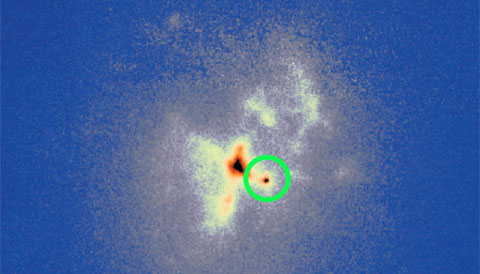Mystery Object in Cygnus A Galaxy - Sky & Telescope
http://www.skyandtelescope.com/astronomy-news/mystery-object-in-cygnus-a-galaxy-1301201623/
Astronomers have discovered an object in the active galaxy Cygnus A that wasn’t there before.
Last week at the American Astronomical Society meeting in Grapevine, Texas, astronomers made an announcement
that’s caught the interest of several researchers: a very bright something has appeared in a well-known galaxy.
That galaxy is the elliptical Cygnus A. Cygnus A is one of the brightest radio sources in the sky. It lies approximately 800 million
light-years from us (redshift of 0.056). In its core sits a supermassive black hole madly eating and cocooned in gas, while two jets
shoot out to either side and light up the intergalactic medium. This activity produces the radio radiation that makes Cygnus A so bright.
Using the recently upgraded Karl G. Jansky Very Large Array (VLA) in New Mexico, Rick Perley (NRAO) and colleagues took a gander at Cygnus
A — the first time the instrument has looked at the galaxy since 1989. (Apparently astronomers spent so much VLA time observing the galaxy
in the 1980s that they didn’t feel the need to look again, Perley joked January 6th in his AAS presentation.) The new observations showed
a surprise: a new, secondary object just southwest of the central black hole. This object wasn’t in the 1989 radio image. Additional, higher-
resolution observations with the Very Long Baseline Array also picked up the object, clearly distinct from the galaxy’s nucleus. It’s roughly
1,300 light-years from the center.
The whatever-it-is is about twice as bright as the brightest known supernova at these frequencies. In fact, it’s much brighter than just about
any transitory radio signal known, except for accreting supermassive black holes and tidal disruption events, outbursts created when a black
hole eats a star.
The team scoured other archives and found the object in 2003 Keck infrared observations and, more iffily, in some images from Hubble.
(The object is so red that it doesn’t show up well at optical wavelengths, and in this range the space telescope’s resolution isn’t as
good as that of Keck’s adaptive optics.)
